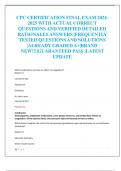CPC CERTIFICATION FINAL EXAM 2024-
2025 WITH ACTUAL CORRECT
QUESTIONS AND VERIFIED DETAILED
RATIONALES ANSWERS |FREQUENTLY
TESTED QUESTIONS AND SOLUTIONS
|ALREADY GRADED A+|BRAND
NEW!!!|GUARANTEED PASS |LATEST
UPDATE
Which medications can have an effect on coagulation?
(Select 2.)
Coenzyme Q10
Flaxseed oil
Echinacea
St. John's wort
Coenzyme Q10
Flaxseed oil
Justification
Anticoagulants, antiplatelet medications, some dietary elements, and herbals have effects on
coagulation. Of the options listed, only coenzyme Q10 and flaxseed oil have an effect.
Which factors heighten the risk for life-threatening hyperkalemia upon administration of succinylcholine
(Anectine)?
(Select 3.)
Muscular dystrophy
Direct muscle trauma
1|Page
,Paraplegia
Acute hepatitis
Hemochromatosis
Pregnancy
Muscular dystrophy
Direct muscle trauma
Paraplegia
Justification
A variety of conditions may lead to hyperkalemia with administration of succinylcholine. Included are
spinal cord trauma, direct muscle trauma, and muscular dystrophy. However, a decrease in
pseudocholinesterase may prolong the effects of succinylcholine, not lead to hyperkalemia. These
conditions include acute hepatitis, hemochromatosis, pregnancy, and obesity with diabetes.
Anesthesia induction for a 70-kg man undergoing resection of a temporomandibular joint includes IV
lidocaine (Xylocaine), 100 mg; propofol (Diprivan), 150 mg; fentanyl (Sublimaze), 150 µg; and
rocuronium (Zemuron), 50 mg. The nares are prepared for nasal intubation with oxymetazoline 0.05%
(Afrin), and dilated with lubricated 30-Fr and 32-Fr nasal trumpets. Prior to nasotracheal intubation, he
becomes profoundly bradycardic, with heart rate of 38/min, blood pressure of 192/102 mm Hg, and
SpO2 of 98%. What is the MOST likely responsible medication for his hemodynamic response?
Lidocaine
Fentanyl
Oxymetazoline
Propofol
Oxymetazoline
Justification
Nasal oxymetazoline is a direct-acting alpha-adrenergic sympathomimetic agonist that causes mucosal
vasoconstriction. Large doses can cause a profound hypertension and reflex bradycardia.
Please use the following information to answer the next 5 questions.
A 78-year-old man presents to the operating room for transurethral resection of the prostate. Upon
chart review, it is noted that he has a history of hypertension, coronary artery disease, and a 50-pack-
year history of smoking cigarettes. His drug list includes metoprolol, hydrochlorothiazide,
2|Page
,fluticasone/salmeterol (Advair) inhaler, and nitroglycerin tablets as needed. His preoperative vital signs
include blood pressure of 159/89 mm Hg, heart rate of 50/min, respiratory rate of 18/min, and room air
oxygen saturation of 93%.
What laboratory test(s) will be MOST important to assess prior to providing anesthesia for this patient ?
Prothrombin time
Creatinine
Potassium
Hematocrit
Potassium
Justification
The patient is on diuretics, so it will be important to draw a potassium level on this patient.
Please use the following information to answer the next 5 questions.
A 78-year-old man presents to the operating room for transurethral resection of the prostate. Upon
chart review, it is noted that he has a history of hypertension, coronary artery disease, and a 50-pack-
year history of smoking cigarettes. His drug list includes metoprolol, hydrochlorothiazide,
fluticasone/salmeterol (Advair) inhaler, and nitroglycerin tablets as needed. His preoperative vital signs
include blood pressure of 159/89 mm Hg, heart rate of 50/min, respiratory rate of 18/min, and room air
oxygen saturation of 93%.
The patient has given consent for regional anesthesia. What is the MOST appropriate technique for the
procedure?
Epidural catheter placement with tetracaine infusion
Subarachnoid block to achieve a T4 sensory level
Epidural catheter placement with a narcotic infusion
Subarachnoid block to achieve a T10 sensory level
Subarachnoid block to achieve a T10 sensory level
Justification
A subarachnoid block at the level of the navel (T10) would be the most appropriate choice for this
anesthetic. T4 would be too high and risk anesthetizing the diaphragm. The epidural with tetracaine
would last far too long and a narcotic epidural would not provide sufficient anesthesia.
3|Page
, Please use the following information to answer the next 5 questions.
A 78-year-old man presents to the operating room for transurethral resection of the prostate. Upon
chart review, it is noted that he has a history of hypertension, coronary artery disease, and a 50-pack-
year history of smoking cigarettes. His drug list includes metoprolol, hydrochlorothiazide,
fluticasone/salmeterol (Advair) inhaler, and nitroglycerin tablets as needed. His preoperative vital signs
include blood pressure of 159/89 mm Hg, heart rate of 50/min, respiratory rate of 18/min, and room air
oxygen saturation of 93%.
After administration of anesthetic, the patient becomes profoundly hypotensive with a blood pressure
of 70/40 mm Hg and heart rate of 40/min. The MOST appropriate next step is to administer:
ephedrine, 5 mg.
phenylephrine, 100 μg.
epinephrine, 100 μg.
dopamine, 10 mg.
ephedrine, 5 mg.
Justification
Administering phenylephrine to a bradycardic patient results in further bradycardia. Dopamine takes
longer to elicit an effect and is usually given via infusion rather than bolus. Ephedrine has mixed
alpha- and beta- adrenergic effects. Epinephrine has a pure alpha-adrenergic effect; it would be less
than ideal at this dose for this patient with coronary artery disease.
Please use the following information to answer the next 5 questions.
A 78-year-old man presents to the operating room for transurethral resection of the prostate. Upon
chart review, it is noted that he has a history of hypertension, coronary artery disease, and a 50-pack-
year history of smoking cigarettes. His drug list includes metoprolol, hydrochlorothiazide,
fluticasone/salmeterol (Advair) inhaler, and nitroglycerin tablets as needed. His preoperative vital signs
include blood pressure of 159/89 mm Hg, heart rate of 50/min, respiratory rate of 18/min, and room air
oxygen saturation of 93%.
After starting the case, it is noted that the surgeon is using glycine as an irrigating solution. What are
potential complications specific to this irrigant?
(Select 2.)
Transient blindness
Elevated ammonia level
Increased bleeding
4|Page




